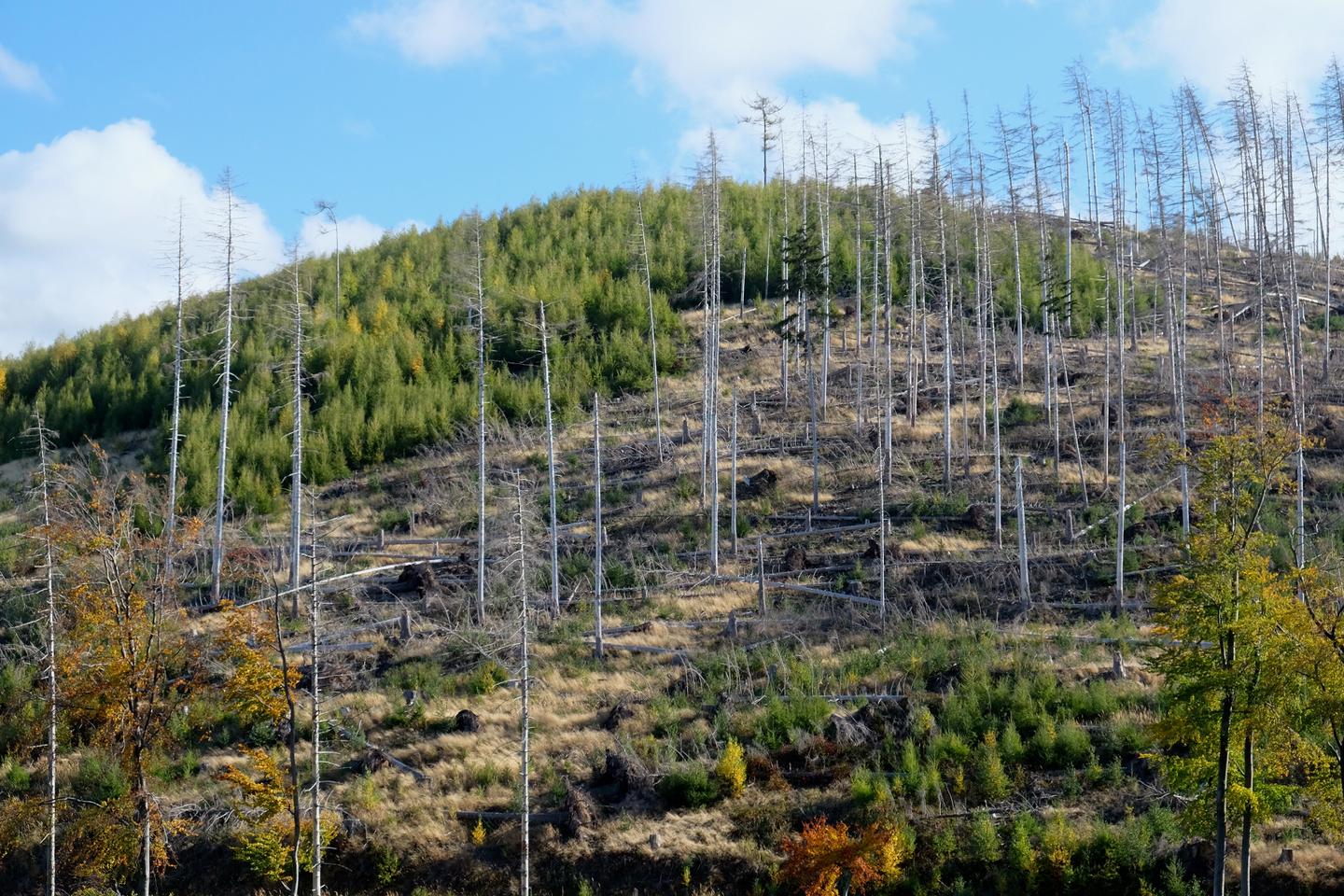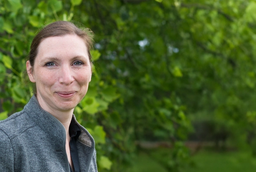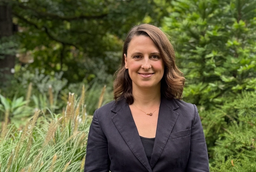Learning climate resilience from natural forests
- November 7, 2024
- 7 min. Reading time

How are the forests of Lower Saxony faring in the face of climate change? How are they coping with the associated challenges? This is what the DIVERSA Climate Future Lab wants to explore. To do this, the scientists at the future lab are drawing on a wealth of different data from which the condition and resilience patterns of the forest can be derived. In this interview, DIVERSA spokesperson Dr Jonas Hagge explains how managed forests can learn from natural forests and how location affects climate resilience.
Hello Dr Hagge, what is the focus of your research at DIVERSA?
DIVERSA focuses on the forest ecosystem and its adaptation strategies to the consequences of climate change. The consequences of climate change are very present in forests and lead to changes that affect, amongst other things, how we use the forest. Therefore, one of our goals is to understand the natural adaptive potential of forests and to generate more knowledge about it. We will investigate how the forest itself adapts to climatic changes and climate extremes. From this, we want to learn how we can also adapt management in such a way that forest management processes become more climate-resilient. In this way, we want to maintain the intrinsic value of forests, but also the services they provide for our society.
In DIVERSA, we are working with a forest concept that includes not only the trees but also the animals and fungi that live in the forest. In one subproject, for example, we are investigating the biodiversity of moths and birds in the forest, because the occurrence of bird and insect species is both an important indicator and an influencing factor for the vitality of the forest.
Which natural mechanisms does the forest use to protect itself from climate change?
The natural resilience mechanisms can be viewed from different perspectives. In general, however, a great deal depends on the identity and diversity of the tree species in the forest, as well as on the location of the trees. Depending on the site characteristics and origin of the trees, the resilience mechanisms and the adaptation potential also differ. In addition, the interaction of different tree species and their respective potential for rejuvenation also plays a role. These synergies can be used to mitigate the effects of climate change on forests. For example, a tree with a high crown that can better withstand heat and direct sunlight could provide shade for trees with lower crowns, thus protecting them from heat damage.
Approximately 95 percent of the forest area in Lower Saxony is managed. There, human intervention in the form of forest management is used to control the forest. In DIVERSA, we are therefore also investigating how targeted forest management can meet our resource demands while at the same time making it climate-resilient. To do this, we specifically select forests that are developing naturally. We then use these examples to understand natural resilience processes, with the aim of transferring these findings to managed forests. Managed forests make use of the natural adaptive potential of the forest, so to speak.
Can you give an example of forest management processes?
Forest management is ultimately about how we manage the forest. The way we derive social and economic benefits from the forest must, of course, also be adapted to climate change.
If we take timber production as an example, we see that something has to change here due to climate change. In the past, spruce or pine were often planted for timber production because these tree species have many favourable characteristics. As a result, about half of the forests in Lower Saxony are coniferous forests, with the consequence that, for example, spruce now also occurs in locations where it would not have grown naturally. These spruce stands now have great difficulty adapting to the consequences of climate change. To make the forest climate-resilient in these places, targeted forest conversion can improve the resilience of the forests by mixing different tree species and creating a diverse stand structure.
Are there forests that are free of forest management processes?
Natural forests, i.e. forests that show no traces of human use, no longer exist in Central Europe. There are individual forests in Lower Saxony that have demonstrably not been managed for over fifty years. However, given that trees live for several hundred years, this period of time does not even correspond to a single tree generation. However, for a forest to return to a natural state, several generations of trees are needed. In these forests, there is still evidence of ‘management legacy’, i.e. changes that can be traced back to human intervention.
Nevertheless, these areas are still very valuable for our research. Here we can observe how natural development processes take place. The changing climate is already causing a change in forests, and management processes are adding a second change to the forest. Climate-related and use-related changes often interact with each other and cannot always be clearly separated. It is therefore very beneficial for climate adaptation that we can also monitor change processes in forests where there is no longer any human intervention.
Processes in the forest take place over very long periods of time and the effects of management decisions often only become apparent 50 to 60 years later. This is a special feature and a challenge of the forest ecosystem. If I plant a tree today, I personally will get little out of it for the time being, but our grandchildren's generation will benefit from it later. So we can set the right course now with our project to ensure the importance of the forest for us as a society in the future as well.
What methodologies do you plan to use to monitor the forest and its adaptability?
We want to get an overall picture of the state of the forests in Lower Saxony. For this, remote sensing data, i.e. satellite and aerial images, are essential. For example, we use thermal radiation and infrared radiation images, which provide us with data on surface temperature and vegetation condition.
We also use existing forest monitoring systems in managed and natural forests. In addition, we will go into the forest ourselves as researchers and carry out measurements and investigations by hand. For example, I cannot see moths in an aerial photograph and identify the species. Scientists have to install light trap systems on site to count the moth population. Bird populations are also determined on site using forest acoustic measurements.
The data collected in this way serves as ‘ground truth’ for our aerial and satellite images. This means that we use it to check what it means on the ground in terms of data if we can see from the remote sensing data that the forest is showing climate-related stress reactions. Our data allows us to determine the extent of the decline in vitality and the types of disturbance present.
We will then summarise our measurement data in a monitoring platform that can map the current state of the forest. This platform can also be used to run scenarios and to predict, in different model runs, how the forest will develop under changeable conditions in the future and how we can intervene in these adaptation processes through targeted forest management.
At which locations will you be taking measurements?
We aim to monitor forest development throughout Lower Saxony and to be able to make statements about the condition of the entire Lower Saxony forest using remote sensing.
One focus of our field surveys will be on the areas of our partner, the Niedersächsische Landesforsten (State Forestry Commission of Lower Saxony). About 30 percent of the forests in Lower Saxony (330,000 hectares) are state-owned and managed by the State Forestry Commission. As a cooperation partner, we are able to conduct research and take measurements in these areas. We are very pleased about this.
You have already touched on the location factor in the forest. What differences does it make, for example, whether a forest is located in a low mountain range or on the coast?
The forest is characterised by its location. From location to location, factors such as mean annual temperature, annual precipitation, wind conditions, soil moisture, etc. differ. If you look at the mean annual temperature, we have a gradient in Lower Saxony that covers about four to five degrees Celsius. That is a very wide range, which of course also has an impact on the forests. For example, it raises the question of which tree species can cope better with higher temperatures and which can cope better with lower temperatures.
How do you intend to involve the stakeholders?
We want to bring together all forest stakeholders, i.e. forest managers, forest owners, foresters, etc., and start a process in which all stakeholders jointly develop a vision of what the forest of the future should look like.
We want to act as a platform for exchange. As researchers, we also aim to provide scientific support and advice for this process. So we are part of the exchange and will research it scientifically.
What will be the first steps in the Klima.Zukunftslabor?
As an interdisciplinary collaborative project, we bring together many different disciplines. This is certainly one of our strengths, but it also brings challenges. To start with, we want to integrate the individual sub-projects into the laboratory and establish processes of cooperation. An important point here will be to find a common language. Every scientific discipline has its own jargon. So for our cooperation, we need to agree on a common vocabulary that everyone can understand.
At the University of Göttingen, there is a second climate future laboratory called FoResLab, which aims to research the climate resilience of forests. What will the collaboration be like here?
We are already in good contact and we will deepen this. At the beginning of next year, we are planning a joint meeting to discuss how we can conduct complementary research and support each other.
Thank you for the interview.
Contact

More Posts
All
Planned climate game receives start-up funding
Nordmedia funds development of a video game on climate issues
1 min. Reading time
1.5 – one scientist, five questions with Prof. Dr. Carola Paul
Head of the Department of Forest Economics and Sustainable Land Use Planning at the University of Göttingen and Principal Investigator in the Climate Future Lab FoResLab
4 min. Reading time
Christiane Thoroe – Communications and public relations Officer
Who we are: The ZKfN-team
2 min. Reading time